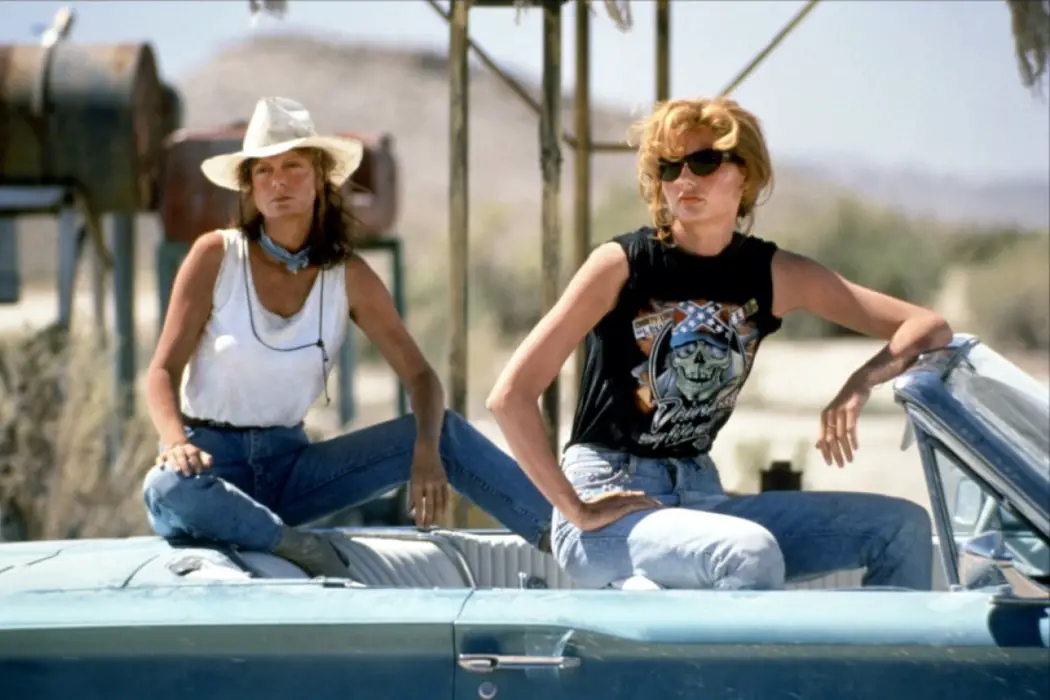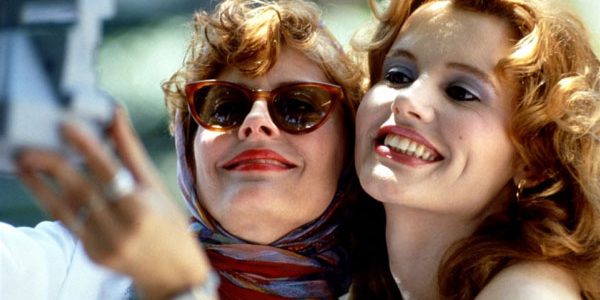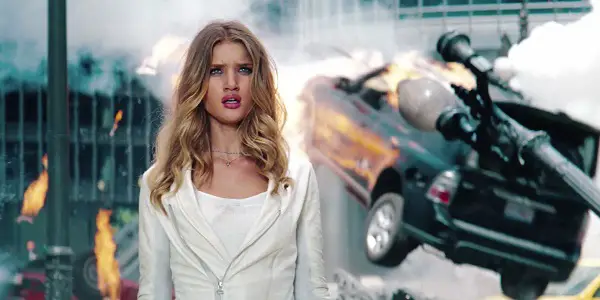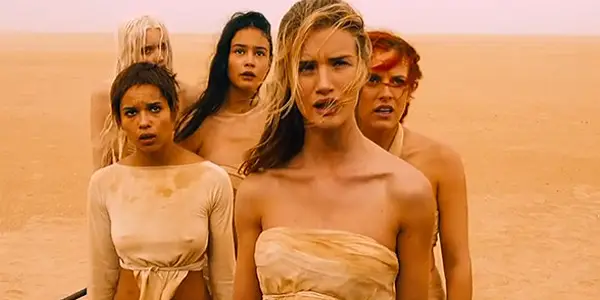The Never Ending Male Gaze: Undercurrents Of Objectification Within Feminist Film

Rachael Sampson is a Northern screenwriter and critic based in…
Feminist film; a necessity, a right, a true telling of OUR stories. Finally. Women in cinema are now winning the bread instead of being filmed in heels and a short skirt baking it in the kitchen. Recently they have been conquering the screen and because of this, the diverse spectrum of the female narrative is finally being depicted in blockbuster and successful indie movies. There is however, an aftertaste that lingers when the credits roll in films such as Thelma and Louise and Mad Max: Fury Road.
Yes, these films are feminist, progressive and incredibly enjoyable, but there are fragments within both (and a range of others just like these) that present mental reservations. It is easy to turn a blind eye and overlook them due to the brilliance of the story, characterisation and the fact that they are undeniably feminist, however if voices aren’t raised, that bitter aftertaste will continue to linger. Just look back at the history of women and minorities, what did silence ever achieve?
The Hysterical Airhead
30 years ago, Thelma and Louise’s 1966 Ford Thunderbird was seen driving audiences into the 90’s. It fueled the feminist fire and steered society closer to that utopian sunset, leaving sexism and stereotypical male-driven narratives in the reflection of the rear-view mirror. It definitely provided thrill and empowerment to all those on board, but a lot of the passengers failed to hear the car backfire.

Thelma (Geena Davis) undergoes a vast transformation, from submissive housewife to rebellious outlaw, however for most of the film, Thelma behaves in such a way that fits the stereotype of a hysterical airhead. Granted she does begin to lose those qualities towards the end of the film, but in comparison to Louise (Susan Sarandon), Thelma is somewhat of a hindrance, highly emotional and causes great obstacles (i.e. when she leaves the money in the hotel for J.D played by Brad Pitt to steal).
Subtle Objectification
Not only does Thelma show character traits feminist films should avoid, she is also objectified – in two scenes in particular. Firstly, when Louise sends her to the pool (for being irritating), Thelma is sunbathing in a bikini and an up-close shot of her groin is included, the scene feels somewhat irrelevant anyway which infers it was solely included for the Davis bikini shot.
Sadly, the groin shots don’t stop there; returning when her and J.D are in the hotel room. It should be noted that there are also some fragments of a shirtless Brad Pitt, but where are your up-close groin shots, Brad?
Sarandon who is 10 years older than Davis, is never shown in a similar sexualised light, which speaks volumes regarding the archaic belief that women have an onscreen sell-by date in relation to sex appeal. If those objectified scenes were included between Davis and Pitt, then why weren’t they included between Sarandon and Michael Madsen?
Casting
The casting of a young Geena Davis for this role was definitely a decision made with aesthetics at heart, which raises the question of, would this film have totally surpassed feminist criticism if there was a woman at the helm instead of Ridley Scott? Only minor changes were needed to extinguish that bitter taste of the male gaze.
From one male director to another: George Miller’s Mad Max: Fury Road is a fantastically feminist film, but like Thelma and Louise, some aspects feel as if there is another agenda on the cards. The casting of Immortan Joe’s wives being one of them. His wives are supposed to be conventionally beautiful which is why he keeps them imprisoned for his personal enjoyment and breeding purposes, however the casting choices made raised a few eyebrows.

Abbey Lee Kershaw had no acting experience prior to the blockbuster – but has a large modeling portfolio. Immortan Joe’s favourite wife, Splendid aka Rosie Huntington-Whitley (Victoria’s Secret model) only has one other acting credit, and that is in a film directed by notorious objectifier and anti-feminist Michael Bay (Transformers: Dark of the Moon).
The Secret Male Gaze
The aesthetic of his wives are important to the story, but not essential. Could it be said that the Male Gaze in this instance has been repackaged by weaving it into the narrative, which subsequently gives the eye candy a hall pass? Sex and sexualisation is not needed to drive a narrative forward, however male directors fail to recognise this, possibly because they are busy directing their production’s penis first – even with feminism at the heart of the movie.
His wives are mostly naked, obvious damsels in distress and their only salvation is Max (Tom Hardy) – a man, and Furiosa (Charlize Theron) – a masculine looking woman. Their desirability is not only shown through Immortan Joe’s shallow polygamy, but also through the eyes of Max when he first stumbles across the women and thinks he is hallucinating.

This bleak dystopia (speculated to be set in 2060) had the opportunity to be even more progressive by simply casting War Boys and War Girls, however from the Citadel there is only one woman engaged in conflict/has interactions with the cars and machinery and that is Furiosa. There is no need for this. A male and female army wouldn’t even have been questioned, yet the audience is deprived of it.
Some people have assumed that there are no War Girls because the women are used solely for the breeding of Immortan Joe, but it is blatantly obvious he is only interested in the “pretty ones”.
The Never Ending Male Gaze: Conclusion
Dissecting feminist films and looking for the minor flaws within them will definitely see some eye-rolls. They are already attempting to tackle the gaze so why would someone want to critique them? The criticism of feminist cinema is not pursued to vilify already progressive works, instead it offers insight into the alternative or subliminal messaging pictures can radiate. A confusing notion when the narrative is largely feminist, but like all movies, they include flaws and reservations.
Returning to that bitter aftertaste a film can leave on the palate – if it isn’t spoken about then it becomes forgotten or dismissed, and future works will lead by their example. Cinema is always evolving, and criticism is central to the evolution of art. Thelma and Louise and Mad Max: Fury Road are both brilliant examples of feminist cinema, and as the years go by, films like these become steppingstones for filmmakers and the public – leading society into a brighter future, one film at a time.
A feminist film doesn’t always send the exact same message to each member of its audience. Just because a film is labelled as progressive, doesn’t mean one shouldn’t question it – and that goes for all styles of cinema. The work may show aspects of empowerment, (rising up towards the Citadel like in Mad Max), and also contain minor doses of unintentional or repackaged patriarchy (causing it to crash and burn at the bottom of the canyon – Thelma and Louise style.) Don’t be afraid to raise questions, voice concerns and contribute to the evolution of feminist cinema.
Which feminist films do you have reservations about? Share your thoughts and comments!
Does content like this matter to you?
Become a Member and support film journalism. Unlock access to all of Film Inquiry`s great articles. Join a community of like-minded readers who are passionate about cinema - get access to our private members Network, give back to independent filmmakers, and more.
Rachael Sampson is a Northern screenwriter and critic based in London. Her latest film is currently in post production and she has 2 shorts cooking in the oven. Rachael is also a published short story author and theatre maker. She often finds herself daydreaming about Andrea Arnold's filmography and firmly believes that Inglourious Basterds is the greatest movie ever made.












